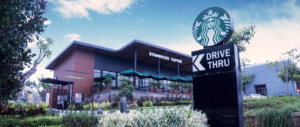Have you ever wondered how a single coffee shop in Seattle transformed into a global coffee empire with a presence in over 80 countries?
What sets Starbucks apart in a world filled with coffee options?
The journey of Starbucks is nothing short of extraordinary, and it’s a tale of unyielding expansion, ingenious localization, and an unmatched commitment to building a brand that resonates with millions.
In this blog, we will unravel the secrets behind Starbucks’ meteoric rise and explore the strategies and factors that have propelled it to the pinnacle of worldwide coffee dominance.

Early Days and Vision
The inception of Starbucks dates back to a humble beginning, driven by the shared passion of three coffee aficionados – Jerry Baldwin, Zev Siegl, and Gordon Bowker. These visionaries embarked on a journey that would ultimately revolutionize the way America, and eventually the world, perceived and consumed coffee.
Their initial vision was elegantly straightforward: to introduce the authentic Italian coffeehouse experience to the United States. At a time when the American coffee scene was dominated by instant coffee and nondescript brews, Starbucks sought to elevate the coffee culture by offering something exceptional.
In its nascent stages, Starbucks found its footing by focusing on the essentials – providing a selection of high-quality coffee beans and top-tier equipment to a niche community of coffee enthusiasts. Their commitment to sourcing the finest coffee beans from around the world, and their dedication to preserving the integrity of those beans through careful roasting, became the foundation of their early success.
However, it wasn’t until the arrival of Howard Schultz in 1982 that Starbucks truly began its remarkable transformation. Schultz, who had experienced the rich coffee culture of Italy, saw the untapped potential for Starbucks to become more than just a supplier of beans and equipment. He recognized that coffee could be more than a beverage; it could be an experience, a social ritual, and a central part of people’s daily lives.
Under Schultz’s leadership, Starbucks embarked on a new trajectory. The company’s mission expanded beyond selling coffee products; it became about creating a vibrant coffeehouse atmosphere where people could gather, connect, and savor the art of coffee. This pivotal shift marked the beginning of Starbucks as we know it today – a place where coffee transcends its utilitarian purpose and becomes a source of inspiration, a meeting point for communities, and an integral part of daily rituals.
The infusion of Schultz’s vision and Starbucks’ commitment to quality set the stage for the brand’s exponential growth and its journey toward global dominance.
The story of Starbucks exemplifies how a simple vision, fueled by passion and a commitment to excellence, can evolve into a worldwide phenomenon that reshapes not only an industry but also the way people experience and appreciate coffee.
Expansion at Home and Abroad
With Howard Schultz at the helm, Starbucks embarked on an ambitious journey of expansion that would eventually redefine the global coffee landscape. Schultz’s visionary leadership and innovative strategies propelled Starbucks from a modest coffee bean supplier to a rapidly growing coffeehouse chain, and this transformation began with a focus on both domestic and international growth.
Under Schultz’s stewardship, Starbucks experienced a remarkable trajectory of expansion. By the year 1987, just five years after Schultz’s arrival, the company had already established a presence with 17 stores, primarily concentrated in the Seattle area. This initial phase of expansion provided a strong foundation upon which Starbucks could build its future empire.
However, it wasn’t long before Starbucks set its sights on the international stage. In 1987, the company ventured beyond U.S. borders, opening its first international store in Vancouver, Canada. This marked a significant milestone for Starbucks, as it signaled the beginning of its global expansion journey.
Key to Starbucks’ expansion strategy was its commitment to saturating local markets before venturing into new ones. This approach was instrumental in their quest for global dominance. By prioritizing a deep presence in key cities and neighborhoods, Starbucks ensured that its brand became an integral part of the local culture and daily routines. This saturation strategy allowed Starbucks to establish a strong and loyal customer base, creating a sense of familiarity and reliability that transcended borders.
The company’s focus on local markets extended beyond the U.S. and Canada. Starbucks continued to replicate this successful model as it expanded internationally, adapting to the unique tastes and preferences of each new market. This localization strategy was critical in winning the hearts of customers worldwide.
For instance, in China, Starbucks introduced beverages like the “Matcha Frappuccino” to cater to local palates, demonstrating a keen understanding of the cultural nuances of each region.
Localization
Starbucks’ remarkable success on the global stage can be attributed, in large part, to its astute strategy of localization. Understanding that people around the world have diverse tastes and cultural preferences when it comes to coffee, Starbucks made a conscious effort to adapt and tailor its offerings to each specific market.
This approach allowed the brand to transcend being merely a global coffee chain; it became an integral part of local communities, a brand that resonated with the unique palates of customers in each new market.
The localization strategy implemented by Starbucks involved a deep understanding of the culinary traditions, flavor profiles, and cultural nuances of the regions they entered. This understanding informed the development of customized menus that catered to local tastes and preferences.
Let’s explore a couple of examples to illustrate how Starbucks successfully localized its offerings:
- Japan: Matcha-Flavored Beverages – In Japan, where traditional tea culture holds a special place, Starbucks recognized the importance of offering something that would appeal to local preferences. As a result, they introduced a range of matcha-flavored beverages, such as Matcha Green Tea Latte and Matcha Frappuccino. These offerings not only incorporated a beloved local flavor but also paid homage to Japanese tea traditions. Starbucks’ commitment to this localization strategy helped it become a favorite destination for Japanese coffee enthusiasts.
- India: Chai Tea Lattes – India, known for its rich and diverse tea culture, presented a unique challenge and opportunity for Starbucks. Recognizing the cultural significance of chai (spiced tea) in India, Starbucks introduced Chai Tea Lattes to its menu. These beverages combined Starbucks’ expertise in espresso with the aromatic spices of Indian chai, creating a fusion that resonated with Indian consumers. This localization effort allowed Starbucks to tap into a market with deep-rooted tea traditions.
By adapting its menu in these and many other ways, Starbucks showcased its commitment to understanding and embracing the local cultures and tastes of its customers. This approach not only set Starbucks apart from its competitors but also created a sense of belonging and familiarity for patrons in each new market.

Creating Third Places
Starbucks’ concept of creating “third places” is a fundamental aspect of its brand identity and success. It represents the idea that Starbucks locations are more than just coffee shops; they serve as a welcoming and comfortable environment that fills the gap between work and home, where people can gather, relax, and socialize. This concept has been pivotal in shaping Starbucks’ reputation and fostering strong customer loyalty.
Here’s a breakdown of how Starbucks executes this concept:
- Comfortable Seating: Starbucks outlets are designed with comfortable seating arrangements that encourage customers to linger and enjoy their time. Whether it’s plush sofas, cozy armchairs, or communal tables, the layout is intentionally crafted to make customers feel at ease. This thoughtful design encourages people to stay longer, engage in conversations, or simply savor their coffee while reading a book.
- Free Wi-Fi: Starbucks was one of the pioneers in offering free Wi-Fi access to its customers. This amenity transformed their stores into hubs for remote work, study sessions, and casual browsing. The availability of Wi-Fi has attracted students, professionals, and freelancers, turning Starbucks into a place where people can be productive while enjoying their coffee.
- Inviting Ambiance: Starbucks pays meticulous attention to the ambiance of its stores. Soft lighting, soothing music, and tasteful decor create a calming atmosphere that is conducive to relaxation and socialization. This ambiance encourages people to escape the hustle and bustle of their daily lives and immerse themselves in a peaceful and enjoyable environment.
- Community Engagement: Starbucks encourages community engagement within its stores. They often host events, such as live music performances, book readings, and art exhibitions, which bring people together and contribute to the sense of community. Starbucks’ commitment to supporting local initiatives and charities also reinforces its role as a community-oriented establishment.
- Customized Experiences: While Starbucks offers a consistent core menu worldwide, they also cater to local tastes. This means that customers can enjoy the familiarity of their favorite Starbucks beverages while also trying region-specific offerings. This customization further enhances the feeling of a “third place” that is unique to each location.
Brand Building and Consistency
Starbucks’ brand building and unwavering commitment to consistency have played a pivotal role in its global success and enduring appeal.
Here’s how Starbucks has built and maintained its iconic brand:
- Iconic Branding: Starbucks’ instantly recognizable green logo, featuring a twin-tailed mermaid or siren, is one of the most iconic symbols in the world of coffee. This logo, with its historical and maritime connotations, has become synonymous with Starbucks and is etched into the minds of consumers globally. The logo’s prominence on Starbucks stores, cups, and packaging reinforces brand recognition and consistency.
- Distinctive Cups: Starbucks’ commitment to its brand extends to its distinctive cups. The classic white cups adorned with the green logo, along with customers’ names handwritten by baristas, create a personal and memorable touch. This consistency in design and presentation reinforces the Starbucks experience and sets it apart from competitors.
- Quality and Consistency: Starbucks has built a reputation for quality and consistency. Regardless of which Starbucks store you visit around the world, you can expect the same high standards in terms of coffee quality, taste, and preparation. This uniformity gives customers confidence that they will receive a consistently great product, no matter where they are.
- The Coffeehouse Experience: Starbucks doesn’t just sell coffee; it offers a complete coffeehouse experience. From the inviting ambiance to the personalized service, Starbucks has created a unique environment that encourages customers to linger, socialize, and enjoy their coffee. This experience is a crucial part of the Starbucks brand and differentiates it from other coffee chains.
- Ethical Sourcing and Sustainability: Starbucks has made significant investments in ethical sourcing and sustainability, which align with the values of socially conscious consumers. They have committed to sourcing coffee beans through ethical and environmentally responsible practices, supporting fair trade, and minimizing their environmental footprint. This commitment has resonated with consumers who want to support companies that share their values.
- Community Engagement: Starbucks actively engages with communities by supporting local initiatives, charities, and educational programs. This community-centric approach demonstrates a genuine commitment to making a positive impact beyond just selling coffee.
- Digital Innovation: Starbucks has also embraced digital innovation, launching its mobile app and loyalty program. This not only enhances the customer experience but also provides valuable data for personalization and customer engagement.
Digital Innovation
Starbucks’ foray into digital innovation has been a key driver of its continued success, enabling the company to extend its reach beyond physical stores and connect with customers in the digital realm. The Starbucks app, launched in 2009, has played a pivotal role in this digital transformation.
Here’s a closer look at how Starbucks leveraged digital innovation:
- Mobile Ordering: The Starbucks app introduced the convenience of mobile ordering, allowing customers to place their orders in advance using their smartphones. This feature has revolutionized the coffee-buying experience, eliminating the need to wait in long lines, especially during peak hours. Customers can browse the menu, customize their drinks, and select a pickup location and time, ensuring their orders are ready when they arrive.
- Mobile Payments: Starbucks was one of the pioneers in introducing mobile payments. With the app, customers can link their credit or debit cards and pay for their orders by simply scanning a barcode on their smartphone at the counter. This seamless payment process not only saves time but also enhances the overall customer experience.
- Rewards and Loyalty Program: The Starbucks app incorporates a rewards and loyalty program, allowing customers to earn stars with each purchase. These stars can be redeemed for free drinks, food items, or merchandise. This incentive-based program not only encourages repeat business but also fosters customer loyalty and engagement.
- Personalization: Through the app, Starbucks collects data on customer preferences and behavior. This data is used to offer personalized recommendations and promotions to individual customers. For example, if a customer frequently orders a particular type of drink, the app may suggest similar items or notify them of relevant promotions, creating a more tailored and enjoyable experience.
- Convenience: The app provides added convenience by allowing customers to reload their Starbucks Card balance, track their reward progress, and view transaction history. It also offers features like finding nearby stores, checking store hours, and accessing nutritional information.
- Digital Gifting: Customers can use the app to send digital Starbucks gift cards to friends and family. This feature enhances the social aspect of Starbucks and encourages gift card recipients to visit Starbucks stores.
- Mobile Order and Pay: Starbucks introduced the “Mobile Order and Pay” feature, which lets customers place orders and make payments entirely through the app. This minimizes contact and promotes social distancing, particularly in response to the COVID-19 pandemic.
Community Engagement and Social Responsibility
Starbucks’ commitment to community engagement and social responsibility goes beyond just serving coffee; it extends to making a positive impact on the communities in which it operates.
This approach has been instrumental in building a positive brand image and forging meaningful connections with customers.
Here’s how Starbucks engages with local communities and demonstrates social responsibility:
- Supporting Local Charities: Starbucks actively contributes to local communities by supporting various charitable initiatives. The company often partners with local nonprofit organizations to address pressing issues, such as homelessness, youth empowerment, or environmental conservation. Through donations and fundraising campaigns, Starbucks channels its resources to make a difference at the grassroots level.
- Hiring Practices: Starbucks is well-known for its inclusive hiring practices. The company has committed to hiring veterans and refugees, among other underrepresented groups in the workforce. By doing so, Starbucks not only provides job opportunities but also demonstrates its commitment to diversity and inclusion. This approach not only benefits the individuals hired but also fosters goodwill in the communities where these practices are implemented.
- Community Events and Initiatives: Starbucks stores often serve as hubs for community events and gatherings. Whether it’s hosting local musicians, artists, or book clubs, Starbucks encourages community engagement within its spaces. These events create a sense of belonging and make Starbucks stores feel like more than just a place to buy coffee; they become community gathering points.
- Local Sourcing: Starbucks places a strong emphasis on sourcing products locally whenever possible. This not only supports local farmers and suppliers but also reduces the carbon footprint associated with transportation. It’s a sustainable approach that benefits both the environment and local economies.
- Ethical Sourcing: Beyond local sourcing, Starbucks is committed to ethical sourcing on a global scale. The company works closely with coffee farmers and communities in coffee-producing regions to ensure fair wages, sustainable farming practices, and improved living conditions. This approach aligns with socially conscious consumer values and reinforces Starbucks’ commitment to responsible business practices.
- Environmental Initiatives: Starbucks has set ambitious sustainability goals, including plans to make its stores more environmentally friendly and reduce its carbon footprint. Initiatives like eliminating plastic straws and sourcing 100% of its electricity from renewable energy sources reflect the company’s commitment to environmental responsibility.
- Education and Youth Programs: Starbucks has implemented educational programs, such as the Starbucks College Achievement Plan, which provides eligible employees with the opportunity to earn a college degree with full tuition coverage. These programs empower employees and invest in their personal and professional growth.
Challenges and Future Outlook
Starbucks, like any global company, has encountered its fair share of challenges and controversies over the years. However, the brand’s ability to confront these issues head-on, adapt, innovate, and stay true to its core values positions it well for continued success in the future.
Here’s an examination of the challenges and future outlook for Starbucks:
Challenges:
- Competition: Starbucks faces intense competition from a wide range of coffee and beverage providers, both large and small. Rivals include other coffeehouse chains, independent coffee shops, and fast-food giants. Staying ahead of the competition and maintaining market share requires ongoing innovation and differentiation.
- Consumer Trends: Consumer preferences and trends in the food and beverage industry are constantly evolving. As health consciousness and sustainability become increasingly important, Starbucks must continue to adapt its menu offerings to meet changing customer expectations.
- Controversies: Starbucks has faced controversies in the past, including issues related to racial bias in its stores and accusations of tax avoidance. Managing these controversies and addressing public concerns is crucial for maintaining the brand’s reputation.
- Economic Factors: Economic fluctuations, currency exchange rates, and global economic events can impact Starbucks’ financial performance, especially as it operates in numerous countries. Economic downturns can affect consumer spending on premium coffee.
Future Outlook:
- Digital Innovation: Starbucks will likely continue to invest in digital innovation to enhance customer convenience and loyalty. This includes further advancements in its mobile app, personalized marketing, and digital ordering capabilities.
- Sustainability: As environmental concerns grow, Starbucks will likely intensify its commitment to sustainability. This may involve reducing its carbon footprint, sourcing more sustainable materials, and supporting ethical and environmentally friendly practices throughout its supply chain.
- Menu Evolution: Starbucks will adapt its menu to reflect evolving consumer preferences, including healthier and more sustainable options. Expect to see continued innovation in coffee and non-coffee beverages, as well as food offerings.
- Global Expansion: While Starbucks already has a significant global presence, it may continue to expand into new markets, particularly in emerging economies. This could involve tailoring its localization strategy to appeal to diverse cultural preferences.
- Community Engagement: Starbucks will likely maintain and expand its community engagement initiatives. Active involvement in local communities not only strengthens the brand’s reputation but also fosters customer loyalty.
- Employee Development: Starbucks will continue to invest in its employees through education and career development programs. A well-trained and motivated workforce is essential for delivering exceptional customer experiences.
- Adaptability: Starbucks’ commitment to adaptability and flexibility will be crucial in navigating unforeseen challenges and changes in the business landscape. The ability to pivot and adjust strategies as needed will help the company remain resilient.
Starbucks’ journey from a single coffee shop in Seattle to a global powerhouse is a testament to its unwavering commitment to expansion, localization, and brand building. By recognizing that coffee is more than just a beverage – it’s an experience – Starbucks has created a global community of coffee lovers. As it continues to adapt and innovate, Starbucks is poised to remain a dominant force in the coffee industry for years to come.
 Pin
PinJoin Accredian’s Executive Program in General Management in partnership with XLRI Delhi today!






